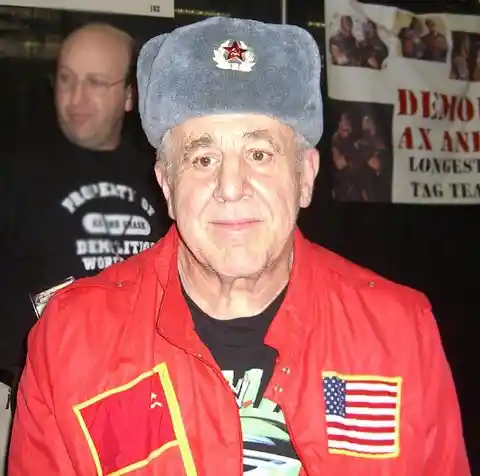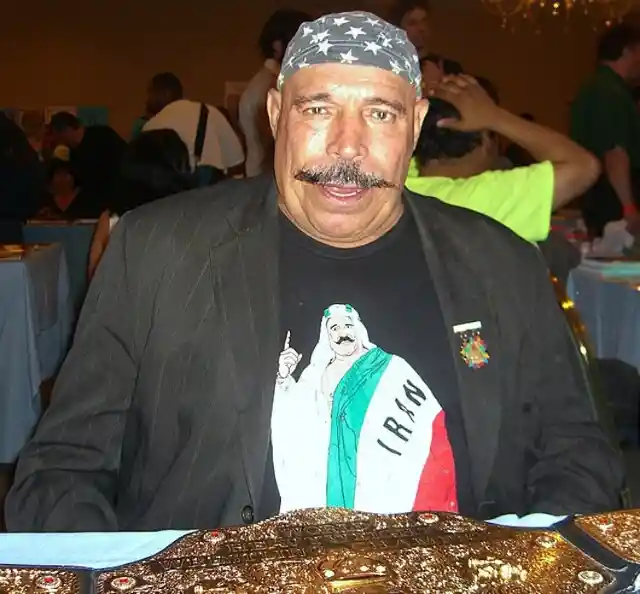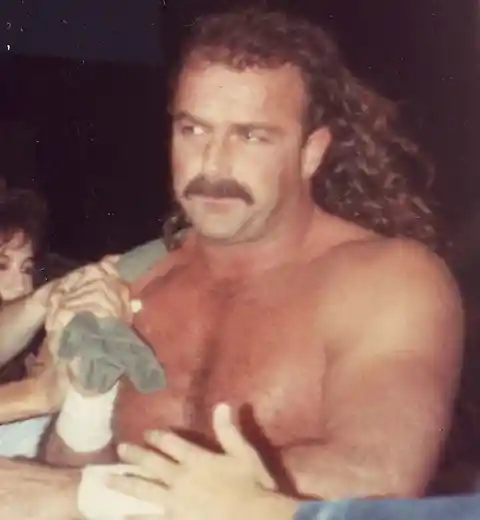Nikolai Volkoff
A great wrestling heel is as timeless as a great babyface. The two are like peanut butter and jelly; good in their own right, but way better when they’re linked up together. The history of wrestling is littered with iconic good guy vs. bad guy feuds, and it’s hard to see where Hulk Hogan and the rest of the wrestling heroes of the 80s and 90s would be today without evil villains to play off of – and no, The Dungeon of Doom doesn’t count. Here are a few of the most despicable heels of the era…


In the 1980s, if you weren’t American, you were almost automatically a heel- and that was especially true if you could play a character from the USSR. Volkoff was a veteran of the scene when he returned to the WWE in the mid-80s. His singing of the Soviet national anthem before matches was instant, incendiary heat, and along with his run as a singles wrestler, he was able to heel it up with the Iron Sheik in a tag team that had to avoid physical attacks in the streets from fans.
The Iron Sheik


The Iron Sheik is a madman. His Twitter game is all you need to see to know that. Having the right gimmick at the right time – think the Iranian Revolution, and the fear of the region in general in the 80s – the Iron Sheik was another foreign heel fed to Hulk Hogan for the American hero to vanquish. It was a simple role, but it’s one that the Sheik played to perfection as he helped launch the success of Hulkamania, and put the company in a position to become the all-encompassing brand it is today.
“The Million Dollar Man” Ted Dibiase


Everyone loves to hate a rich guy. That simple concept is what got Ted DiBiase, who’d buy his way to the top, over as a heel in the 80s. DiBiase’s in-ring promos became must-see TV, as he’d offer fans a fat wad of cash if they’d complete some humiliating challenge while being trash-talked by the eloquent DiBiase about how worthless they were. It was an act that’s been repeated down the years, with the likes of JBL and Alberto Del Rio also taking the smug rich guy route to heel success, but DiBiase was the trailblazer in knowing that everyone has a price.
“Rowdy” Roddy Piper
The Hot Rod was one of Hulk Hogan’s most notable opponents during his run in the mid-80s. Perhaps historically overshadowed by the likes of Andre the Giant and “Macho Man” Randy Savage, Piper and his famous Piper’s Pit segment was instrumental in the building of the Rock ‘n’ Wrestling connection that helped launch the industry into the mainstream in time for the first Wrestlemania. Piper is, as a result, best known for his somewhat (very) racially insensitive Pit segment, which involved Jimmy “Superfly” Snuka and a bunch of coconuts, and for being in the main event at the first Mania alongside Hogan and Mr. T.


Jake “The Snake” Roberts
A cerebral heel the likes of which we hadn’t really seen before, Jake Roberts was a master of psychology both in and out of the ring. A character that was actually disarming to those watching – even before he pulled a python or a cobra out of his bag – Roberts took the art of being a bad guy to a whole new level with his words and creepy demeanor. No one who was watching will ever forget the sight of Roberts’ pet cobra locking his fangs into Macho Man Randy Savage’s arm, as part of their epic feud in 1991.
Bobby “The Brain” Heenan
The best heel manager and announcer in the history of the business, Heenan had the ability to draw heat no matter who he was working with. Willing to take any bump to sell a match, countless wrestlers through the years have received a push based on the antics of Heenan during their matches. An amazing wrestling mind, Heenan had that knack of interfering at just the right time to sell a match, and always being in the right spot to get what was coming to him. His later mic work – specifically his call of Ric Flair winning the 1992 Royal Rumble – is some of the best of all time.


The Undertaker
The Undertaker has flipped between heel and baby face as much as anyone not named The Big Show throughout his career. Debuting as part of the Million Dollar Team assembled by Ted DiBiase, The Undertaker character was a no-nonsense machine that was genuinely frightening, whether managed by Brother Love or Paul Bearer. After some face work in the middle of the decade, The Undertaker turned truly villainous during his run as the Lord of Darkness, including one segment at Wrestlemania XV where he hung The Big Boss Man from the top of Hell in a Cell.


“Macho Man” Randy Savage
“Macho Man” Randy Savage was a wrestler who was before his time in terms of his ability to tell stories in the ring. While he’d had a great run as a baby face, much of Savage’s best work came as a heel, albeit a heel that occasionally hit too close to home in the treatment of his wife, Elizabeth. It was this bully portrayal that took Savage to Wrestlemania III and a date with Ricky Steamboat – one of the best babyfaces of all time – in a match that many consider the greatest of the decade, if not the greatest ever. His work with Hulk Hogan after the breakup of the Mega Powers was further proof that Savage could always get the reaction he wanted from a crowd.
Ric Flair
There isn’t a territory where he worked where Ric Flair wasn’t the most hated man on the card at some point during his career. A promo machine, Flair knew every trick in the book to get the fans to hate him, whether it was his first night in town, or if he’d been working the city for years. The eight-time NWA champion and self-styled ‘dirtiest player in the game’ was also the leader of the greatest heel stable in wrestling history, The Four Horsemen.
“The Heartbreak Kid” Shawn Michaels
Some wrestlers are great heels because they’re able to take the worst part of their personalities and amplify them. Michaels was a great heel because his unpleasant personality was entirely who he was (before his later run, after finding his faith). From the moment that Michaels disbanded The Rockers on an episode of Superstars that aired in January 1992, by launching poor Marty Jannetty face-first through the Barbershop Window, it was obvious he was going to become a star. Blessed with a finishing move in Sweet Chin Music that could be launched out of nowhere (pre-Randy Orton), Michaels made up for his less than imposing stature with his skill set, and smart use of managers and bodyguards, throughout his career.
Mr. McMahon
Vincent Kennedy McMahon saved his company with a drastic move to portray himself as an onscreen character, opposite Stone Cold Steve Austin, in the last couple of years of the 90s. McMahon proved to be the ultimate foil for Austin – a power-hungry boss who’d stop at nothing to beat and humiliate his most hated employee. It worked because it was a scenario every working man or woman could relate to, and we’d all feel a sense of satisfaction when Austin was able to get one up on his nemesis. McMahon deserves all of the credit in the world for allowing himself to be continually made to look like an idiot as the boss of a multibillion-dollar enterprise in order to pop a TV rating.


“Hollywood” Hulk Hogan
When ‘The Immortal’ Hulk Hogan revealed himself as the third man alongside The Outsiders at WCWs Bash at the Beach 1996, it turned the wrestling world on its head. Hogan – a pure white-meat babyface for essentially the entirety of his career in the spotlight – was suddenly the most hated wrestler on the planet, a role he slipped into seamlessly. It helped that fans had grown tired of his character and that his backstage politicking had become more evident, so audiences around the world were able to buy into his cowardly heel personality. Ditching the red and yellow for black and white extended Hogan’s run at the top, and changed the idea of what professional wrestling could be.